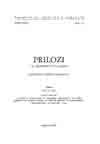Osobitosti arapskog deminutiva
Characteristics of arabic diminutive
Author(s): Teufik MuftićSubject(s): Language and Literature Studies
Published by: Orijentalni Institut u Sarajevu
Summary/Abstract: The most common way of diminutive formation in the Arabic literary language (diminution, tasgir or tahqir) with basic forms: fu'ail, fu'ai'il and fu'ai'il, derived from various non-reduced forms, has been described in detail in Arabic normative grammar since the time of its first systematist Sibawaih. That is why this study provides only the most important information about this form. The second, much rarer way of diminution of those same basic forms, but done through derivation from the very root to which the concrete forms of the words from which one wants to obtain a diminutive are reduced, has been pointed out here in comparison with the first form. This has been done for two reasons. First, because of the existence of these two forms there appears, on.the one hand, the formation of double diminutive forms of the same non-reduced word [e. g., from 'usfur can be formed: l) 'usaifir or 2) 'usaifir; from hamra': 1) (humaira' or 2) (humairat, etc.]. On the other hand in the second way of diminution in the word having the same root, diminutive forms cannot be differentiated (e. g. of the woro with the root f-r-s: faris and faras the common diminutive form reads: furais, whereas in the first way the diminutives of these words are mutually clearly distinguishable and read: fuwairis or furais). Due to this possibility of distinguishing the forms of diminutives of words derived from the same root, the first manner has probably prevailed over the second in the living language practice.
Journal: Prilozi za orijentalnu filologiju
- Issue Year: 1976
- Issue No: 22-23
- Page Range: 269-280
- Page Count: 12
- Language: Bosnian

